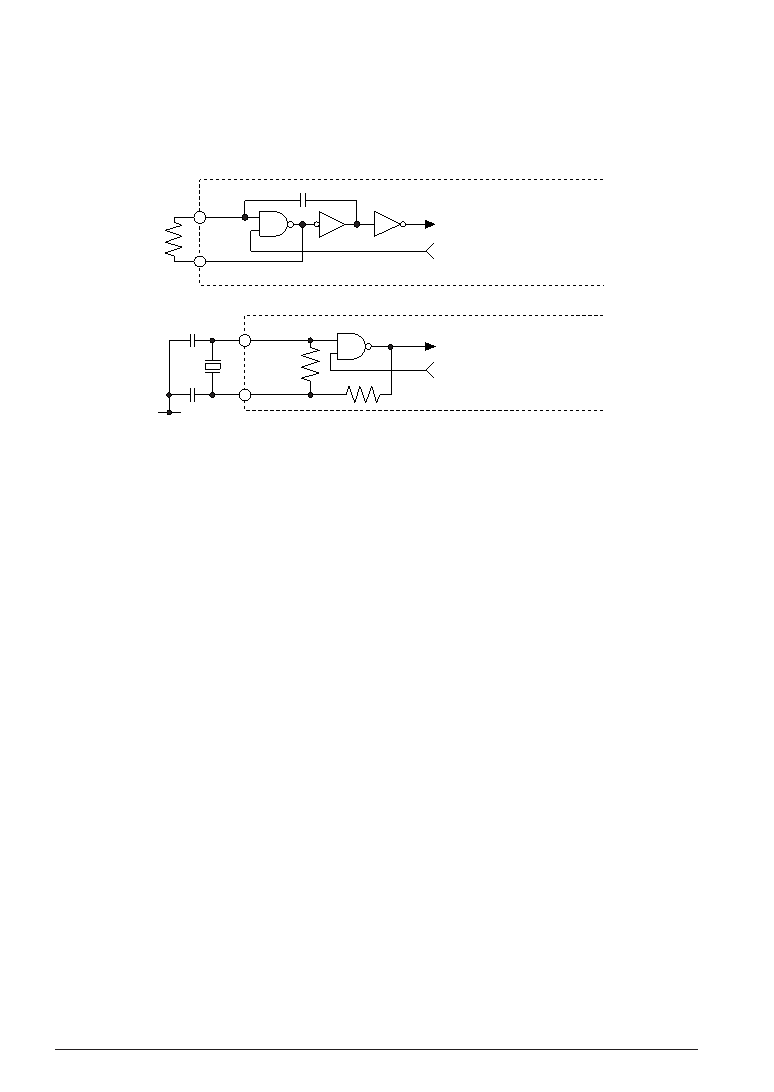- 您現(xiàn)在的位置:買賣IC網(wǎng) > PDF目錄98068 > S1C60L16F0A0100 4-BIT, MROM, 0.032768 MHz, MICROCONTROLLER, PQFP80 PDF資料下載
參數(shù)資料
| 型號: | S1C60L16F0A0100 |
| 元件分類: | 微控制器/微處理器 |
| 英文描述: | 4-BIT, MROM, 0.032768 MHz, MICROCONTROLLER, PQFP80 |
| 封裝: | PLASTIC, QFP14-80 |
| 文件頁數(shù): | 27/105頁 |
| 文件大?。?/td> | 841K |
| 代理商: | S1C60L16F0A0100 |
第1頁第2頁第3頁第4頁第5頁第6頁第7頁第8頁第9頁第10頁第11頁第12頁第13頁第14頁第15頁第16頁第17頁第18頁第19頁第20頁第21頁第22頁第23頁第24頁第25頁第26頁當(dāng)前第27頁第28頁第29頁第30頁第31頁第32頁第33頁第34頁第35頁第36頁第37頁第38頁第39頁第40頁第41頁第42頁第43頁第44頁第45頁第46頁第47頁第48頁第49頁第50頁第51頁第52頁第53頁第54頁第55頁第56頁第57頁第58頁第59頁第60頁第61頁第62頁第63頁第64頁第65頁第66頁第67頁第68頁第69頁第70頁第71頁第72頁第73頁第74頁第75頁第76頁第77頁第78頁第79頁第80頁第81頁第82頁第83頁第84頁第85頁第86頁第87頁第88頁第89頁第90頁第91頁第92頁第93頁第94頁第95頁第96頁第97頁第98頁第99頁第100頁第101頁第102頁第103頁第104頁第105頁

18
EPSON
S1C60N16 TECHNICAL MANUAL
CHAPTER 4: PERIPHERAL CIRCUITS AND OPERATION (Oscillation Circuit)
4.3.3 OSC3 oscillation circuit (S1C60A16)
The S1C60A16 has built-in the OSC3 oscillation circuit that generates the CPU's sub-clock (Typ. 1 MHz)
for high speed operation and the source clock for the serial interface. The mask option enables selection
of CR or ceramic oscillation circuit.
Figure 4.3.3.1 is the block diagram of the OSC3 oscillation circuit.
C CR
OSC3
OSC4
R
CR
VSS
CGC
CDC
Ceramic
OSC4
OSC3
R
RDC
FC
To CPU
(and serial interface)
Oscillation circuit control signal
To CPU
(and serial interface)
Oscillation circuit control signal
(a) CR oscillation circuit
(b) Ceramic oscillation circuit
S1C60A16
Fig. 4.3.3.1 OSC3 oscillation circuit
As shown in Figure 4.3.3.1, the CR oscillation circuit can be configured simply by connecting the resistor
RCR between the OSC3 and OSC4 terminals when CR oscillation is selected. See Chapter 7, "Electrical
Characteristics", for resistance value of RCR.
When ceramic oscillation is selected, the ceramic oscillation circuit can be configured by connecting the
ceramic oscillator (Typ. 1 MHz) between the OSC3 and OSC4 terminals, capacitor CGC between the OSC3
and OSC4 terminals, and capacitor CDC between the OSC4 and VSS terminals. See Chapter 7, "Electrical
Characteristics", for capacitor values of CGC and CDC. To reduce current consumption of the OSC3
oscillation circuit, oscillation can be stopped by the software (OSCC register).
For the S1C60N16 and S1C60L16 (single clock model), do not connect anything to terminals OSC3 and
OSC4.
4.3.4 Switching the system clock (S1C60A16)
In the S1C60A16, the CPU system clock is switched to OSC1 or OSC3 by the software (CLKCHG register).
When OSC3 is to be used as the CPU clock, it should be done as the following procedure using the
software: turn the OSC3 oscillation ON and wait at least 5 msec for oscillation stabilization, then switch
the CPU clock after waiting 5 msec or more.
When switching from OSC3 to OSC1, switch the CPU clock, then turn the OSC3 oscillation circuit off.
OSC1
→ OSC3
OSC3
→ OSC1
1. Set OSCC to "1" (OSC3 oscillation ON).
1. Set CLKCHG to "0" (OSC3
→ OSC1).
2. Maintain 5 msec or more.
2. Set OSCC to "0" (OSC3 oscillation OFF).
3. Set CLKCHG to "1" (OSC1
→ OSC3).
相關(guān)PDF資料 |
PDF描述 |
|---|---|
| S1C60N01F | 4-BIT, MROM, 0.08 MHz, MICROCONTROLLER, PQFP48 |
| S1C60N02D | 4-BIT, MROM, 0.08 MHz, MICROCONTROLLER, UUC52 |
| S1C60L02 | 4-BIT, MROM, 0.08 MHz, MICROCONTROLLER, PQFP60 |
| S1C60N04D | 4-BIT, MROM, 2 MHz, MICROCONTROLLER, UUC48 |
| S1C60N08D | 4-BIT, MROM, 0.032768 MHz, MICROCONTROLLER, UUC96 |
相關(guān)代理商/技術(shù)參數(shù) |
參數(shù)描述 |
|---|---|
| S1C60N05 | 制造商:EPSON 制造商全稱:EPSON 功能描述:4-bit Single Chip Microcomputer |
| S1C60N08 | 制造商:EPSON 制造商全稱:EPSON 功能描述:4-bit Single Chip Microcomputer |
| S1C60N16 | 制造商:EPSON 制造商全稱:EPSON 功能描述:4-bit Single Chip Microcomputer |
| S1C60R08 | 制造商:EPSON 制造商全稱:EPSON 功能描述:4-bit Single Chip Microcomputer |
| S1C63004 | 制造商:EPSON 制造商全稱:EPSON 功能描述:CMOS 4-bit Single Chip Microcontroller |
發(fā)布緊急采購,3分鐘左右您將得到回復(fù)。